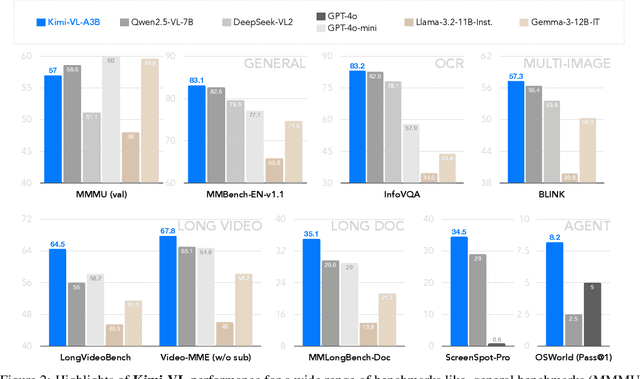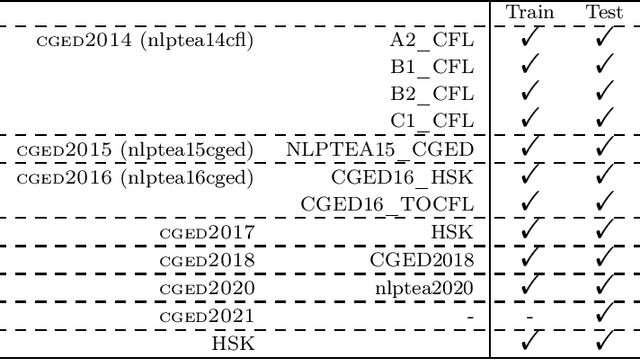Zihao Huang
School of Information Science and Technology, ShanghaiTech University
UltraMemV2: Memory Networks Scaling to 120B Parameters with Superior Long-Context Learning
Aug 26, 2025



Abstract:While Mixture of Experts (MoE) models achieve remarkable efficiency by activating only subsets of parameters, they suffer from high memory access costs during inference. Memory-layer architectures offer an appealing alternative with very few memory access, but previous attempts like UltraMem have only matched the performance of 2-expert MoE models, falling significantly short of state-of-the-art 8-expert configurations. We present UltraMemV2, a redesigned memory-layer architecture that closes this performance gap. Our approach introduces five key improvements: integrating memory layers into every transformer block, simplifying value expansion with single linear projections, adopting FFN-based value processing from PEER, implementing principled parameter initialization, and rebalancing memory-to-FFN computation ratios. Through extensive evaluation, we demonstrate that UltraMemV2 achieves performance parity with 8-expert MoE models under same computation and parameters but significantly low memory access. Notably, UltraMemV2 shows superior performance on memory-intensive tasks, with improvements of +1.6 points on long-context memorization, +6.2 points on multi-round memorization, and +7.9 points on in-context learning. We validate our approach at scale with models up to 2.5B activated parameters from 120B total parameters, and establish that activation density has greater impact on performance than total sparse parameter count. Our work brings memory-layer architectures to performance parity with state-of-the-art MoE models, presenting a compelling alternative for efficient sparse computation.
GaussianArt: Unified Modeling of Geometry and Motion for Articulated Objects
Aug 20, 2025Abstract:Reconstructing articulated objects is essential for building digital twins of interactive environments. However, prior methods typically decouple geometry and motion by first reconstructing object shape in distinct states and then estimating articulation through post-hoc alignment. This separation complicates the reconstruction pipeline and restricts scalability, especially for objects with complex, multi-part articulation. We introduce a unified representation that jointly models geometry and motion using articulated 3D Gaussians. This formulation improves robustness in motion decomposition and supports articulated objects with up to 20 parts, significantly outperforming prior approaches that often struggle beyond 2--3 parts due to brittle initialization. To systematically assess scalability and generalization, we propose MPArt-90, a new benchmark consisting of 90 articulated objects across 20 categories, each with diverse part counts and motion configurations. Extensive experiments show that our method consistently achieves superior accuracy in part-level geometry reconstruction and motion estimation across a broad range of object types. We further demonstrate applicability to downstream tasks such as robotic simulation and human-scene interaction modeling, highlighting the potential of unified articulated representations in scalable physical modeling.
Kimi K2: Open Agentic Intelligence
Jul 28, 2025Abstract:We introduce Kimi K2, a Mixture-of-Experts (MoE) large language model with 32 billion activated parameters and 1 trillion total parameters. We propose the MuonClip optimizer, which improves upon Muon with a novel QK-clip technique to address training instability while enjoying the advanced token efficiency of Muon. Based on MuonClip, K2 was pre-trained on 15.5 trillion tokens with zero loss spike. During post-training, K2 undergoes a multi-stage post-training process, highlighted by a large-scale agentic data synthesis pipeline and a joint reinforcement learning (RL) stage, where the model improves its capabilities through interactions with real and synthetic environments. Kimi K2 achieves state-of-the-art performance among open-source non-thinking models, with strengths in agentic capabilities. Notably, K2 obtains 66.1 on Tau2-Bench, 76.5 on ACEBench (En), 65.8 on SWE-Bench Verified, and 47.3 on SWE-Bench Multilingual -- surpassing most open and closed-sourced baselines in non-thinking settings. It also exhibits strong capabilities in coding, mathematics, and reasoning tasks, with a score of 53.7 on LiveCodeBench v6, 49.5 on AIME 2025, 75.1 on GPQA-Diamond, and 27.1 on OJBench, all without extended thinking. These results position Kimi K2 as one of the most capable open-source large language models to date, particularly in software engineering and agentic tasks. We release our base and post-trained model checkpoints to facilitate future research and applications of agentic intelligence.
Multilingual Grammatical Error Annotation: Combining Language-Agnostic Framework with Language-Specific Flexibility
Jun 09, 2025



Abstract:Grammatical Error Correction (GEC) relies on accurate error annotation and evaluation, yet existing frameworks, such as $\texttt{errant}$, face limitations when extended to typologically diverse languages. In this paper, we introduce a standardized, modular framework for multilingual grammatical error annotation. Our approach combines a language-agnostic foundation with structured language-specific extensions, enabling both consistency and flexibility across languages. We reimplement $\texttt{errant}$ using $\texttt{stanza}$ to support broader multilingual coverage, and demonstrate the framework's adaptability through applications to English, German, Czech, Korean, and Chinese, ranging from general-purpose annotation to more customized linguistic refinements. This work supports scalable and interpretable GEC annotation across languages and promotes more consistent evaluation in multilingual settings. The complete codebase and annotation tools can be accessed at https://github.com/open-writing-evaluation/jp_errant_bea.
Kimi-VL Technical Report
Apr 10, 2025



Abstract:We present Kimi-VL, an efficient open-source Mixture-of-Experts (MoE) vision-language model (VLM) that offers advanced multimodal reasoning, long-context understanding, and strong agent capabilities - all while activating only 2.8B parameters in its language decoder (Kimi-VL-A3B). Kimi-VL demonstrates strong performance across challenging domains: as a general-purpose VLM, Kimi-VL excels in multi-turn agent tasks (e.g., OSWorld), matching flagship models. Furthermore, it exhibits remarkable capabilities across diverse challenging vision language tasks, including college-level image and video comprehension, OCR, mathematical reasoning, and multi-image understanding. In comparative evaluations, it effectively competes with cutting-edge efficient VLMs such as GPT-4o-mini, Qwen2.5-VL-7B, and Gemma-3-12B-IT, while surpassing GPT-4o in several key domains. Kimi-VL also advances in processing long contexts and perceiving clearly. With a 128K extended context window, Kimi-VL can process diverse long inputs, achieving impressive scores of 64.5 on LongVideoBench and 35.1 on MMLongBench-Doc. Its native-resolution vision encoder, MoonViT, further allows it to see and understand ultra-high-resolution visual inputs, achieving 83.2 on InfoVQA and 34.5 on ScreenSpot-Pro, while maintaining lower computational cost for common tasks. Building upon Kimi-VL, we introduce an advanced long-thinking variant: Kimi-VL-Thinking. Developed through long chain-of-thought (CoT) supervised fine-tuning (SFT) and reinforcement learning (RL), this model exhibits strong long-horizon reasoning capabilities. It achieves scores of 61.7 on MMMU, 36.8 on MathVision, and 71.3 on MathVista while maintaining the compact 2.8B activated LLM parameters, setting a new standard for efficient multimodal thinking models. Code and models are publicly accessible at https://github.com/MoonshotAI/Kimi-VL.
Chinese Grammatical Error Correction: A Survey
Apr 01, 2025



Abstract:Chinese Grammatical Error Correction (CGEC) is a critical task in Natural Language Processing, addressing the growing demand for automated writing assistance in both second-language (L2) and native (L1) Chinese writing. While L2 learners struggle with mastering complex grammatical structures, L1 users also benefit from CGEC in academic, professional, and formal contexts where writing precision is essential. This survey provides a comprehensive review of CGEC research, covering datasets, annotation schemes, evaluation methodologies, and system advancements. We examine widely used CGEC datasets, highlighting their characteristics, limitations, and the need for improved standardization. We also analyze error annotation frameworks, discussing challenges such as word segmentation ambiguity and the classification of Chinese-specific error types. Furthermore, we review evaluation metrics, focusing on their adaptation from English GEC to Chinese, including character-level scoring and the use of multiple references. In terms of system development, we trace the evolution from rule-based and statistical approaches to neural architectures, including Transformer-based models and the integration of large pre-trained language models. By consolidating existing research and identifying key challenges, this survey provides insights into the current state of CGEC and outlines future directions, including refining annotation standards to address segmentation challenges, and leveraging multilingual approaches to enhance CGEC.
Free4D: Tuning-free 4D Scene Generation with Spatial-Temporal Consistency
Mar 26, 2025Abstract:We present Free4D, a novel tuning-free framework for 4D scene generation from a single image. Existing methods either focus on object-level generation, making scene-level generation infeasible, or rely on large-scale multi-view video datasets for expensive training, with limited generalization ability due to the scarcity of 4D scene data. In contrast, our key insight is to distill pre-trained foundation models for consistent 4D scene representation, which offers promising advantages such as efficiency and generalizability. 1) To achieve this, we first animate the input image using image-to-video diffusion models followed by 4D geometric structure initialization. 2) To turn this coarse structure into spatial-temporal consistent multiview videos, we design an adaptive guidance mechanism with a point-guided denoising strategy for spatial consistency and a novel latent replacement strategy for temporal coherence. 3) To lift these generated observations into consistent 4D representation, we propose a modulation-based refinement to mitigate inconsistencies while fully leveraging the generated information. The resulting 4D representation enables real-time, controllable rendering, marking a significant advancement in single-image-based 4D scene generation.
Expert Race: A Flexible Routing Strategy for Scaling Diffusion Transformer with Mixture of Experts
Mar 20, 2025Abstract:Diffusion models have emerged as mainstream framework in visual generation. Building upon this success, the integration of Mixture of Experts (MoE) methods has shown promise in enhancing model scalability and performance. In this paper, we introduce Race-DiT, a novel MoE model for diffusion transformers with a flexible routing strategy, Expert Race. By allowing tokens and experts to compete together and select the top candidates, the model learns to dynamically assign experts to critical tokens. Additionally, we propose per-layer regularization to address challenges in shallow layer learning, and router similarity loss to prevent mode collapse, ensuring better expert utilization. Extensive experiments on ImageNet validate the effectiveness of our approach, showcasing significant performance gains while promising scaling properties.
Frac-Connections: Fractional Extension of Hyper-Connections
Mar 18, 2025Abstract:Residual connections are central to modern deep learning architectures, enabling the training of very deep networks by mitigating gradient vanishing. Hyper-Connections recently generalized residual connections by introducing multiple connection strengths at different depths, thereby addressing the seesaw effect between gradient vanishing and representation collapse. However, Hyper-Connections increase memory access costs by expanding the width of hidden states. In this paper, we propose Frac-Connections, a novel approach that divides hidden states into multiple parts rather than expanding their width. Frac-Connections retain partial benefits of Hyper-Connections while reducing memory consumption. To validate their effectiveness, we conduct large-scale experiments on language tasks, with the largest being a 7B MoE model trained on up to 3T tokens, demonstrating that Frac-Connections significantly outperform residual connections.
NAT-NL2GQL: A Novel Multi-Agent Framework for Translating Natural Language to Graph Query Language
Dec 11, 2024



Abstract:The emergence of Large Language Models (LLMs) has revolutionized many fields, not only traditional natural language processing (NLP) tasks. Recently, research on applying LLMs to the database field has been booming, and as a typical non-relational database, the use of LLMs in graph database research has naturally gained significant attention. Recent efforts have increasingly focused on leveraging LLMs to translate natural language into graph query language (NL2GQL). Although some progress has been made, these methods have clear limitations, such as their reliance on streamlined processes that often overlook the potential of LLMs to autonomously plan and collaborate with other LLMs in tackling complex NL2GQL challenges. To address this gap, we propose NAT-NL2GQL, a novel multi-agent framework for translating natural language to graph query language. Specifically, our framework consists of three synergistic agents: the Preprocessor agent, the Generator agent, and the Refiner agent. The Preprocessor agent manages data processing as context, including tasks such as name entity recognition, query rewriting, path linking, and the extraction of query-related schemas. The Generator agent is a fine-tuned LLM trained on NL-GQL data, responsible for generating corresponding GQL statements based on queries and their related schemas. The Refiner agent is tasked with refining the GQL or context using error information obtained from the GQL execution results. Given the scarcity of high-quality open-source NL2GQL datasets based on nGQL syntax, we developed StockGQL, a dataset constructed from a financial market graph database. It is available at: https://github.com/leonyuancode/StockGQL. Experimental results on the StockGQL and SpCQL datasets reveal that our method significantly outperforms baseline approaches, highlighting its potential for advancing NL2GQL research.
 Add to Chrome
Add to Chrome Add to Firefox
Add to Firefox Add to Edge
Add to Edge